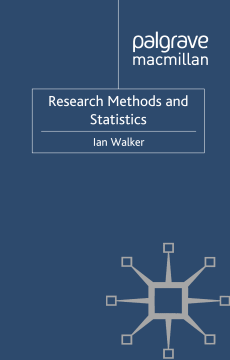
Additional Information
Book Details
Abstract
Whether it's designing a study, conducting an experiment, or analyzing the results, research methods are an integral part of Psychology. In this student-friendly introduction, Walker covers the different types of study, quantitative data, statistics and ethics. This book is the perfect tool to help build students' confidence in this vital area.
IAN WALKER is Lecturer in Psychology and Director of Studies for Master of Research at the University of Bath, UK, and is co-author of Research with People (Palgrave Macmillan, 2009).
"Ian Walker makes the basic topics in statistics accessible, providing interesting examples and explanations. A great A-level text or as a supplement for those Undergraduate students who feel less confident taking a statistics course for the first time."- Sarah Bayless, Lecturer in Psychology, University of Winchester
"I was unsure about studying psychology, but reading Research Methods and Statistics by Ian Walker put all these worries behind me. It is really well written and very readable - all I can say is 'wow, amazing!'" - Jack Herbert, First Year Psychology student, University of Derby
Table of Contents
| Section Title | Page | Action | Price |
|---|---|---|---|
| Cover | Cove | ||
| Contents | vi | ||
| List of figures | viii | ||
| Note from series editors | x | ||
| Preface | xii | ||
| Section One: Research Methods | 1 | ||
| 1 Introduction | 3 | ||
| 2 The first three stages of designing a research project | 10 | ||
| 3 Who will you test and what will this tell you? Understanding populations and samples | 21 | ||
| 4 Major types of quantitative research | 29 | ||
| 5 Qualitative research and questionnaires | 45 | ||
| 6 Research ethics | 54 | ||
| Section Two: Statistics | 63 | ||
| 7 Using statistics to describe research findings | 67 | ||
| 8 Displaying data with graphs and tables | 86 | ||
| 9 Hypothesis testing, and the only two errors you can possibly make with statistics | 96 | ||
| 10 Did you see what you expected to see? Understanding the chi-squared test | 116 | ||
| 11 One of the most useful things you’ll ever learn: the normal distribution | 132 | ||
| 12 When is a number not a number? Understanding levels of measurement | 146 | ||
| 13 How to tell whether two sets of numbers are different from each other | 156 | ||
| 14 Looking at relationships – measures of correlation | 181 | ||
| 15 Analysing and presenting qualitative data | 197 | ||
| Section Three: Reports, and some thoughts | 203 | ||
| 16 Writing research reports | 205 | ||
| 17 A few short warnings about statistics | 212 | ||
| 18 Statistics in the real world | 218 | ||
| Appendix A: Normal distribution table | 220 | ||
| Appendix B: Worked examples of tests for comparing two means: t-tests, the Mann-Whitney U test and the Wilcoxon matched-pairs signed-ranks test | 224 | ||
| Appendix C: Calculating correlations | 241 | ||
| Glossary | 245 | ||
| Index | 252 | ||
| Reading guide | 258 |
